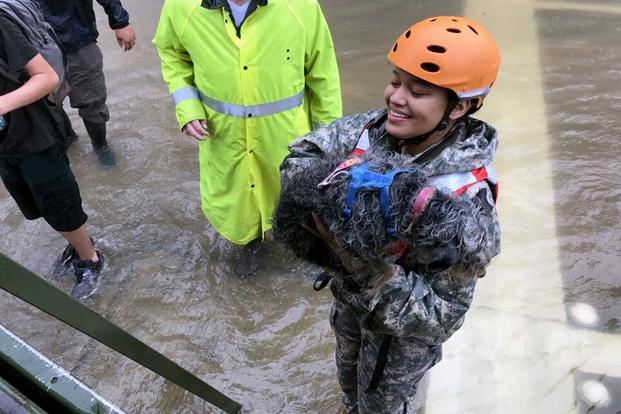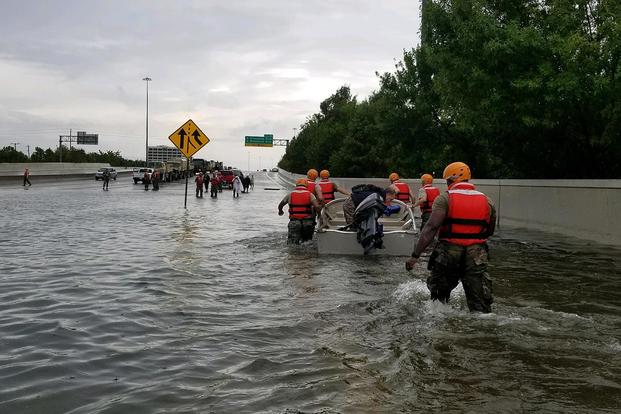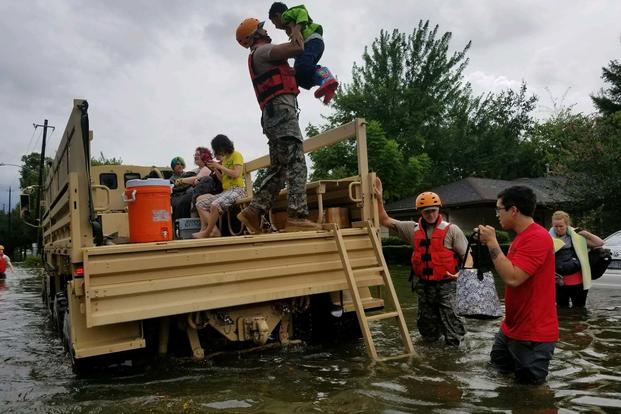The number of troops engaged in rescue and relief Wednesday in the aftermath of Hurricane Harvey totaled about 7,600 in Texas and Louisiana, and upwards of 30,000 troops have been put on standby, the Pentagon said Wednesday.
A Pentagon spokesman said 4,300 National Guard troops were engaged mostly in search and rescue operations in Texas, and that number could rise to 14,000 in the next 48 hours. About 500 Guard troops were already mobilized in Louisiana and their number could go up to 1,000 by Friday, the spokesman said.
In addition, about 2,800 active-duty troops have deployed or were about to deploy to Texas, the spokesman said. Thousands more active-duty troops were in the pipeline, awaiting a formal request for their deployment from Gov. Gregg Abbott, R-Texas, according to Pentagon officials.
At the Pentagon Tuesday, Maj. Gen. James Witham, the National Guard Bureau's Director of Domestic Operations, said that 20,000-30,000 National Guard troops and thousands more active-duty troops were on standby to go to Texas and Louisiana if they get the call to assist overwhelmed Texas authorities.
The skies cleared over Houston Wednesday but torrential remnants of Harvey made landfall again near Port Arthur, Texas, and the southwestern Louisiana Gulf Coast on a path expected to take the storms through Shreveport, Louisiana.
Related content:
- 1st Cav Sends 400 Troops, 100 Vehicles for Houston Hurricane Recovery
- Up to 30K More Guard Troops Ready to Respond to Harvey
- What Hurricane Response Activation Means for National Guard Families
- Here's How Harvey Is Impacting Military, Veteran Benefits
- Texas Activates Entire State National Guard for Harvey Aftermath
- Harvey-Related Rescues Keep US Coast Guard Busy
There were varying accounts of the death toll, ranging from 16 to 22, from the storms and floods in the aftermath of Hurricane Havey, which hit the Texas Gulf Coast Friday as a Category 4 storm with winds up to 130 mph and has now been downgraded to a tropical storm with winds of about 45 mph.
Houston Police Chief Art Acevedo said "We just pray that the body count won't rise significantly" as rescue teams search abandoned neighborhoods.
On Wednesday, about 400 troops and 100 vehicles from the Army's 1st Cavalry Division began arriving in Houston to join rescue and recovery efforts in the flooded city.
The troops left Tuesday from their post at Fort Hood, Texas, about 200 miles northwest of Houston, in a series of convoys, a base spokesman said.
The units involved from 1st Cav's 13th Expeditionary Sustainment Command included the 36th Engineer Brigade, 48th Chemical Brigade, 85th Civil Affairs Brigade, 89th Military Police Brigade, 504th Military Intelligence Brigade, 11th Signal Brigade and 1st Medical Brigade.
On Tuesday at the Pentagon, Maj. Gen. Witham said the military was planning on a lengthy involvement in storm relief and recovery, and was taking a "phased approach" to bringing in troops and equipment.
"Just like our first responders get tired and burn out, guardsmen will also get tired and burn out as we do this. So this has to be a phased approach, and Texas is planning for that phased approach, not only with their organic National Guard forces, but National Guard forces that could be brought in from surrounding states through emergency assistance compacts," Witham said.
"So this has to be a phased approach, and Texas is planning for that phased approach, not only with their organic National Guard forces, but National Guard forces that could be brought in from surrounding states through emergency assistance compacts," Witham said.
-- Richard Sisk can be reached at Richard.Sisk@Military.com.
Related Video:

































